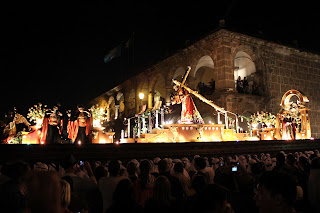 |
| A Procession during Semana Santa in Antigua |
Guatemala is one of the world's major cultural destinations, offering one of the most popular processional traditions which are original, authentic and unique in Latin America. From the pre-Hispanic indigenous cultural heritage and traditions followed by the colonial conquistadors to contemporary times, all of these traditions are fused in this marvelous land full of contrasts.
The most traditional cultural events in Guatemala are:
- Semana Santa or Holy Week, is celebrated each year between March and April and is a religious tradition that was started in 1543, when the Spanish moved the Holy Sacrament of Old City to Santiago de Guatemala, which was the capital of Guatemala, which today is known as Antigua Guatemala. The biggest attraction of Easter are handmade carpets with beautiful designs made of seeds, dust, flowers and colorful processions with marching bands.
-La Carrera de Caballos Todos Santos Cuchumatán is a traditional horse race at an annual fair in Cuchumatán, which begins October 23 and ends on November 3. They organize various cultural activities in this municipality and is visited by domestic and foreign tourists.
- Los Barriletes de Santiago Sacatepéquez is a fun tradition, held every November 1 in Santiago and in Zacatepequez Sumpango. This is a festival that involves giant kites that soar to the sky with messages to ancestors, and thus commemorating the Day of the Dead. These giant and decorative kites are designed by locals with great care and artistry.
-La Qema del Diablo, or The Burning of the Devil, is an exciting tradition held every December 7th throughout the country. Market stalls begin selling papier–mâché devils a week before. The tradition of burning the devil began in colonial times. In anticipation of the feast of the Immaculate Conception, the patron of Guatemala City, those who could afford it adorned the fronts of their houses with lanterns. Eventually, the poor who could not afford such lanterns began gathering their garbage and would burn all of the year's rubbish in front of their houses. Over time it was formalized and in addition to individual piles of garbage, communities started to burn The Devil to clear the way for Mary's feast.
The idea is to burn all of the bad from the previous year and to start anew from the ashes. In cities throughout the country The Devil is burned at the stroke of six. In Ciudad Vieja, the first capital of the country, a devil three stories tall is constructed and burned in the city square.
http://youtu.be/ZBH4OqLSBw8
This is by no means an exhaustive list of Guatemala's traditions as there are so many throughout the country, but it does illustrate just how culturally rich and exciting Guatemala is. Every tradition is meaningful whether it is pre-hispanic, established by the Indigenous or a tradition that came from the Spanish Conquistadors. Either way, we are left with lots of excitement.




No comments:
Post a Comment